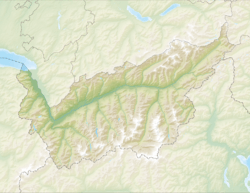Salins, Switzerland facts for kids
Quick facts for kids
Salins
|
||
|---|---|---|
|
||
| Country | Switzerland | |
| Canton | Valais | |
| District | Sion | |
| Area | ||
| • Total | 4.1 km2 (1.6 sq mi) | |
| Elevation | 842 m (2,762 ft) | |
| Population
(2010)
|
||
| • Total | 982 | |
| • Density | 239.5/km2 (620/sq mi) | |
| Postal code |
1991
|
|
| Surrounded by | Les Agettes, Nendaz, Sion, Veysonnaz | |
Salins was once a small town, or municipality, located in the Valais region of Switzerland. It was part of the Sion district. On January 1, 2013, Salins joined with the larger city of Sion. This means Salins is no longer a separate municipality.
Contents
A Look Back at Salins' History
Salins was first mentioned in old records around the year 1200. Back then, it was called Salaig. A few years later, in 1227, its name changed slightly to Salen. For a while, it was also known by its German name, Schalein, but this name is not used anymore.
Where is Salins? Geography and Land Use
Before it joined Sion, Salins covered an area of about 4.1 square kilometers (1.6 square miles). A big part of this land, about 32.6%, was used for farming. This includes fields for crops, pastures for animals, and areas for fruit trees or grapevines.
More than half of Salins, about 51.2%, was covered by forests. These forests were mostly dense woods. About 14.7% of the land was developed with buildings and roads. A very small part, less than 1%, was unproductive land, meaning it couldn't be used for farming or building.
Salins is located in the Sion district. It sits on the left side of the Rhone river. The area includes the main village, Salins-Village, and several smaller communities called hamlets, like Mézeriez.
Salins' Coat of Arms
Every town has a special symbol called a coat of arms. Salins' coat of arms is blue. It shows two golden stars with six points. Between these stars, there are two golden bundles of grain, crossed over each other like an "X". This design is called Azure, between two Mullets [of Six] Or as many Garbs of the same in saltire.
People and Population of Salins
In 2010, Salins had a population of 982 people. About 8.5% of these people were not Swiss citizens. Over ten years, from 2000 to 2010, the population grew by 14.4%. This growth happened because more people moved into Salins than left, and there were more births than deaths.
Most people in Salins speak French. In 2000, about 95.2% of the population spoke French as their main language. German was the second most common language, spoken by 2.6% of the people. A small number, 0.8%, spoke Italian.
In 2008, the population was almost evenly split between males and females. About 48.7% were male, and 51.3% were female. Most residents were Swiss citizens.
Many people living in Salins in 2000 were born there (37.4%). Others were born in the same canton (40.3%) or elsewhere in Switzerland (11.4%). About 9.4% of the population were born outside of Switzerland.
In 2000, children and teenagers (up to 19 years old) made up about 24.6% of the population. Adults (20 to 64 years old) were the largest group, at 59.2%. Seniors (over 64 years old) made up 16.2%.
Most households in Salins had about 2.5 people. There were also some households with just one person, and some with five or more people.
The chart below shows how the population of Salins has changed over many years:

Economy and Jobs in Salins
In 2010, the unemployment rate in Salins was 3.7%. This means a small percentage of people who wanted to work couldn't find jobs.
Many people in Salins worked in different types of jobs:
- Primary Sector: This includes jobs like farming. In 2008, 75 people worked in this area, with 17 businesses.
- Secondary Sector: This includes jobs in manufacturing (making things) and construction (building things). There were 34 people working here, with 8 businesses.
- Tertiary Sector: This includes jobs in services, like sales, transportation, hotels, and education. 115 people worked in this sector, with 23 businesses.
Overall, 418 residents of Salins had jobs. About 40.9% of these workers were female.
Many people who lived in Salins traveled to other towns for work. In 2000, 344 people left Salins for their jobs, while only 56 people came into Salins to work. This shows that Salins was a place where many people lived but worked elsewhere. Most people (81.8%) used a private car to get to work, while a smaller number (7.9%) used public transportation.
Religion in Salins
Based on the 2000 census, most people in Salins were Roman Catholic, making up about 85.7% of the population. A smaller group, 5.7%, belonged to the Swiss Reformed Church.
There were also a few people who belonged to other Christian churches, or to Islam or Buddhism. About 4.08% of the population did not belong to any church or had no religious beliefs.
Education in Salins
Education is important in Salins. In 2000, about 37.1% of the population had finished their non-mandatory upper secondary education. This is like high school.
Additionally, 12.5% of the people had completed higher education. This means they went to a university or a specialized college (called a Fachhochschule). Most of these highly educated individuals were Swiss men and women.
In 2000, 69 students from Salins went to schools outside the municipality. Only 8 students from other towns came to school in Salins.
See also
 In Spanish: Salins (Valais) para niños
In Spanish: Salins (Valais) para niños




